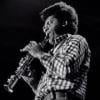
As far as I can ascertain, the last time avant-garde saxophonist Anthony Braxton played a solo concert in Southern California was 1988, in the intimate venue of the Santa Barbara Museum of Art’s auditorium. He bedazzled the small but eager crowd, mostly true believers who seemed to feel duly blessed.
After the show, in an interview at a nearby Chinese restaurant, Braxton, a good-natured intellectual, joked, “This goes to show even senior saxophonists can play and have people show up at their concerts. I’ve become a putz-er now, at 42. I specialize in ballads.” Among countless other things.
On Friday, Braxton finally paid a return visit to SoCal with only his alto sax in tow. We can thank the adventurous Los Angeles-based presenters The Unwrinkled Ear and Black Editions for this artistic coup, one of the major experimental musical events of the season. Once again, Braxton bedazzled, but this time before a much larger contingent of listeners in the vast sanctuary of L.A.’s First Congregational Church.

As heard on his memorable solo albums, starting with 1971’s For Alto, the saxophonist has long savored dualities. He embraces jazz standards even as he dismantles and reshapes them. Through his experimental practice, Braxton has carved out a boldly original artistic path. Now 78, he has a MacArthur “genius” grant and an NEA Jazz Master Fellowship among his accolades. He’s a living titan, ranging through a broad and uniquely personal oeuvre that includes new music, opera (his hyper-ambitious and ongoing Trillium Opera Complex), and jazz as such — although he shies away from the implied limitations of the j-word — in settings from solo to large ensemble. But you can detect the grander Braxtonian vision even in what he does with just an alto saxophone. Friday’s performance felt complete and full.
In the nearly full sanctuary, Braxton appeared in a post-professorial getup — sweater and tousled hair, as if set ablaze by the mental energies and multidirectional voltages of his brain.
A paradigm of control and contained abandon, Braxton’s concert — a longer set and a shorter one, adding up to about an hour — pushed some outer limits but within a tidy framework of his devising. He performed 10 discrete pieces, and each was marked by its own distinctive character, defining parameters and qualities, and areas of exploration in miniature.
Braxton delved into dynamics, colorations of harmony (or lack thereof), timbral and technical effects, and abstract painterly angles. As if gauging the ambience and acoustics of the “room,” with its reverberant lavishing of long tones, the saxophonist opened with a languid, lyrical ballad. Then, he immediately made a sharp left turn, issuing a fragile mix of skittering lines and clean, lean tones in furtive crosstalk in one piece, jockeying intervals in another, and pure tones yielding to ragged multiphonics and weeping gestures in another. And in a following piece, long tones floated into the high-ceilinged chapel with a wistful sweetness amid harsher elements and more abstract designs elsewhere.
Contrasts abounded but conspired toward a greater whole in a yearning, twisted take on “Body and Soul.” Lest we be lulled into thinking of Braxton as a mischievous standards-bearer, the concert-closing segment was one of the more decidedly abstract pieces of the evening, bristling with extreme dynamic shifts, like an internal dialogue of divergent voices.
Before the finale, the sage musician shared a few state-of-the-world comments to expand the range of his instrumental statements. “This is a complex time cycle,” he said with his rapid-tongued eloquence. “We’re going to find a way to move out of this strange dynamic and put things back together. … The cosmic forces bless our planet.”
On the evidence of this magical evening and the densely packed artistic adventure of his life thus far, you could say Braxton himself is a cosmic force.



